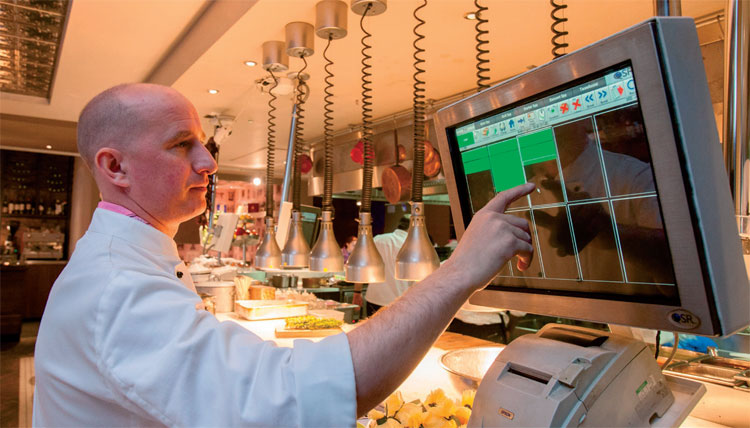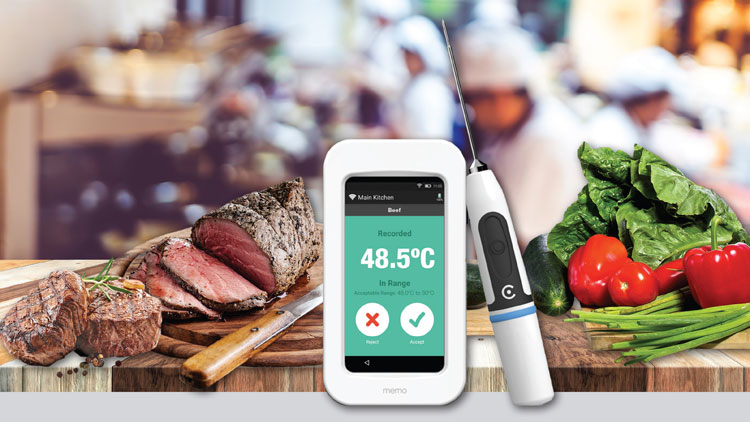Sponsored by QSR Automations
Connecting the dots: all you need to know about back of house tech

Clever, behind the scenes gadgets and technologies are being developed all the time to ease the pressures on a busy kitchen, from food safety monitoring systems to staff management. Here, we take a look at some of the latest advancements in technology designed to ease back-of-house operations and better link the kitchen with front of house.
Automated kitchen management
According to research by technology supplier Zonal, food not arriving quickly enough is the biggest frustration for diners (72% cited slow food delivery as their biggest bugbear in Zonal’s GO Technology research). And the complaint is common to all age groups, particularly at lunchtimes when many are watching the clock and when every second is vital.
So anything that can aid communication between front of house and the kitchen – speeding up food delivery and minimising incorrect orders – has got to be a big advantage. Zonal has developed an intelligent kitchen and service management system, Kitchen iQ, that integrates with EPoS software, eases communication between teams and helps reduce waste to improve efficiency and profitability.
Once orders are taken, kitchen screens, which can be personalised for any operation, present the information in a clear and concise format, confining paper orders to the dustbin. Orders are automatically routed to their correct cooking stations, with warning and alert times set, and the system notifies wait staff when an order is ready.
For multi-site operators Kitchen iQ offers central configuration with the ability to change and update screens across whole or part of an estate, and business intelligence is delivered through real-time reporting on order, prep and wait times at both site and estate levels.
For smaller operators, Kitchen iQ is designed to grow with the business, with the option to add screens and further reporting functionality when needed. QSR Automations’ ConnectSmart Kitchen (CSK) system also integrates with EPoS and brings an array of benefits.
“ConnectSmart Kitchen helps operators achieve their goals through features like kitchen video, customised viewing options, advanced diagnostics, and an array of routing options for any restaurant operation’s needs. It empowers kitchens to function at their best, removing guesswork and errors and unifying processes,” says vice-president of sales Ashley Sheppard.
And QSR has recently adapted its technology in response to the huge growth in delivery.
“Consumers are the ones driving the off-premise and delivery craze, so restaurant operators need data-powered solutions to meet their demands. Our latest enhancements blend the two streams of traffic – incoming orders from on-site and off-premise – to keep them from overwhelming the kitchen,” explains Sheppard.
What’s more, CSK is integrated with the company’s front-of-house application DineTime, enabling customers to order ahead and dine in. “Guests can get in line and order ahead through the operator’s website or app. Once the guest is seated at the restaurant, the order will fire to the kitchen,” adds Sheppard.
Stock management and ordering
In these days of increasing costs, an intuitive stock management system could mean the difference between a business staying afloat or going under. Unmonitored wastage, long administration processes with ordering, manual line checks and inaccurate stock counts are just some of the problems operators face when they don’t have a technological solution in place.
“The right, intuitive stock management system not only assists in resolving these challenges, but it’s a tool that can really help drive a business forward in efficiency and profitability,” says Tevalis sales director James Humble. “Key features such as recipe and menu engineering are a great example of this, providing operators with accurate cost calculations of their recipes alongside a recommended selling price to achieve their target GP. Features such as this as well as barcode stock taking, supplier management and par and consumption level ordering, are truly critical for those who want to take control of ordering, managing and analysing stock.”
Following client consultation, Tevalis has developed a new stock management application, called TevStock, which will be released early this year and integrates with the core Tevalis Stock Management module.
With TevStock, teams will be able to perform key functions at the tap of a button, such as barcode scanning for their line checks and stock takes (where the data is then synced into the core Stock Management module), completing outstanding purchase orders, and the creation and authorisation of stock transfers.
Designed with chefs in mind, Kitchen CUT offers an array of tools to simplify back of house work and make restaurants more profitable. Created by chef-turned-international restaurant consultant John Wood, it allows managers to monitor performance at a glance and make instant and informed operational decisions. Key functions include supplier management, recipe costing, menu planning, allergen tracking, nutritional analysis, stock depletions, inventory management, wastage tracking and digital menus. Detailed reporting and analytics and a scaleable group network make Kitchen CUT a good fit for larger businesses.
“To survive, businesses need to find a way of working smarter, driving improved performance and becoming more time efficient. Kitchen CUT has been designed to tackle back-of-house operational issues by improving process management. Adopting Kitchen CUT reduces the duplication of tasks and actions, improves visibility and consistency of product and processes,” says Simon Haynes, CTO of Kitchen CUT.
Pager technology and communications
Good communication, between wait staff and guests and between front and back-of-house, is vital to a smoothly run and, ultimately, successful restaurant. A highly effective solution for improving that communication is pager technology.
On-site wireless communications specialist Call Systems Technology (CST) supplies pagers for use by diners waiting for a table, as well as pagers for waiting staff. “Wait lists using paging or mobile technology allow customers to join an invisible queue, giving them the freedom to wait where they wish until their table is ready. Customers are handed a pager on arrival which will then alert them when their table becomes free,” says CST managing director Eloise Sheppard.
Waiter pagers allow chefs to announce once an item of food is ready, transmitting a signal to the pager of the waiter responsible through a vibration, flash or beep tone. Not only does a pager eliminate the need for front-of-house teams to run back and forth to the pass, it also reduces raised voices, creating a peaceful eating environment.”
Staff management
People are the single most important asset for any successful restaurant operation, but they can also be your biggest and most unpredictable expense. It’s essential for admin time to be kept to a minimum so general managers and teams can get on with what they do best, and this is where the latest technology can help.
For instance, Access Hospitality’s cloud-based technology automates staff procedures, from the initial recruitment and induction process through to payroll, time and attendance, scheduling, training and tips management.
One of Access’s key solutions is its absence management software which enables effortless management of holidays, shifts and sickness, with managers and employees able to organise holidays and shifts from their mobile. Real-time data means unit managers can make well-informed decisions on resourcing.
Access Workspace connects all of Access’s applications through one sign-in and one screen, and allows personalised drag-and-drop dashboards to be created by individual staff, giving them easy access to all relevant business operations, from HR to payroll, property, EPoS, purchase to pay and reservations.
“It’s intuitive, able to be customised and enables users to organise apps, tasks, company information and project work to suit how they work on any given day,” says Access Hospitality managing director Henry Seddon.
Rival tech firm Fourth says its workforce management solution brings huge advantages when recruiting the right staff and retaining them, while its Fourth Analytics platform gives operators a huge amount of business insight critical to making strategic decisions.
“Ensuring you attract and retain the best people is an ongoing challenge for the hospitality industry,” says Fourth director of labour productivity Karina Coen. “Our integrated HR systems allow team members to swap shifts quickly via an app, without impacting forecasting and introducing unnecessary admin. It might seem simple, but the ability to streamline the day-to-day tasks of employees can significantly impact their length of tenure.”
Fourth has recently partnered with Wagestream in a move that will give hospitality workers complete control over when they get paid. Through Wagestream’s technology, integrated with Fourth’s pay solution, staff can withdraw the pay they have earned up to that point, including tips, at any time during any month, thus improving employee welfare.
Temperature monitoring and kitchen workflow systems
Using pen and paper checklists to run food safety, whether you have a single venue or multiple sites, can be a risky business. “It’s not reliable, it’s inefficient and, worst of all, you might not know what you are risking until it’s too late,” says David Davies, product and marketing director at tech company Checkit.
Davies says you should ask yourself some important questions. Are my checks being done when they should? Are problems being dealt with promptly? Can I trust records have been completed accurately? Are temperatures being properly controlled? Have we remembered to update allergen records? What happens if an inspection happens tomorrow?
And, for larger operations, which suppliers are having deliveries constantly rejected? Which sites need attention from regional managers this week? How is site A performing against site B?
“Answering these questions is crucial to keeping operating at a high standard, identifying problems early and managing risks. And if you are relying on printing, filling in and collecting sheets of paper, answering them is made even more difficult,” Davies says.
That’s where a real-time operations management and food safety system like Checkit’s comes in. For staff on the front line, Checkit guides and enforces activities with simple step-by-step apps (digital checklists), which can run on Checkit’s food-safe Memo touch-screen device or any mobile.
Checkit’s smart wireless-sensing networks use Internet of Things technologies to replace manual checks with 24-7 monitoring to protect valuable stock and processes. Routine fridge and freezer checks are a thing of the past, with complete records available whenever an inspection takes place.
For supervisors, Checkit automatically allocates and schedules work, making non-compliances and issues easy to handle. And for operations and regional managers, Operational Insights dashboards can monitor and compare performance across sites and teams.
“The result is improved performance, reduced risk and real-time insight, enabling a new approach to audit, based on continual data from the coal face,” adds Davies
The Insider - Ashley Sheppard
Vice president of sales, QSR
Why should operators consider automated kitchen management systems?
For me the number one reason is consistency, closely followed by guest experience. There are a lot of challenges out there at the moment. Competition is the strongest it’s ever been. The right solution gives operators the best opportunity to deliver a great experience. People are low on time, they need good quality food fast. It also reduces food wastage. In an uncertain marketplace with a strong competitive edge, operators need to know how their kitchens are performing at all times so they are able to reactive proactively to ensure guest expectations are met at all times.
This is just as important when they are considering their delivery/take out strategy as well as instore dining. How do your customers know when their order is going to be ready, without offering them a guestimate? How do your delivery partners know when they should arrive to collect their order from the restaurant, or should they just wait outside in the hope it will be ready soon, running the risk of upsetting local residents? It’s all about the data, and when used correctly it can have a hugely positive impact on all operations, something printers fail to deliver.
Kitchen automation is more established in the US than in the UK, how far do we have to go?
The US is seen as a birthplace for most hospitality technology and much progress has been made in the UK with the advancement of technology within our restaurants, however we are yet to see printer replacement as widespread as it is in North America. Of the top 25 casual dining chains in the US, 20 are already adopters of this technology. It’s impossible to truly understand back-of-house operations without first examining the data, and without the use of kitchen automation systems, such as QSR’s ConnectSmart solution, this is very difficult to achieve.
How do your front and back of house systems interact with each other?
They can both be used standalone and have a highly positive effect on operations. But when you use them both together it’s something else. They really talk to each other, we’re quite unique in that. Our front of house system is updated from the back of house. Dinetime can quote table times based on historical kitchen data and we can also share live kitchen data with delivery partners and consumers themselves.
What’s next in back of house tech?
AI and robotics. That’s where the investment is at the moment. Check out the Cali Group’s CaliBurger if you’re not convinced. It’s a restaurant group that’s using robots to reduce labour costs – it’s impressive stuff.
















